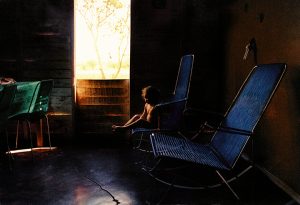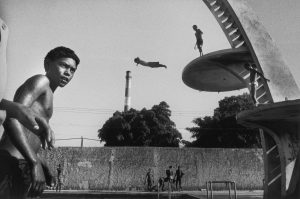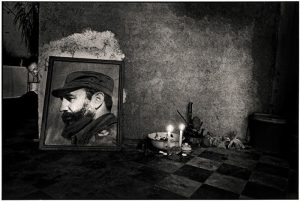There are many photographers who accompany and complete their profession with teaching. But often the numerous workshops that populate the Festivals are not the legacy, nor the sharing of an experience destined to germinate in the participants. Teaching is a vocation and continuous formation – it is said – and as such it is nourished by sharing and generosity. The international photographer Ernesto Bazan has made his teaching the construction of an extended family: the students who participate in his Workshops are friends who select the shots during editing and layouts. These are the points of a drawing that touches the capitals of the world. Each Workshop of Bazan, who today after the long experience in Cuba lives in New York, is spiritual communion, education to the inner eye for a sensitivity of approach to reality.
Simone Azzoni: You love teaching as much as photography. Being a teacher and being a photographer are two complementary experiences that build an educating community…
Ernesto Bazan: It is another gift that I received from life, first the gift of becoming a photographer and then suddenly, this new need. At first I thought it would help me financially: I worked for magazines and I wanted to get rid of them because I was tired of doing freelance. Then I realized that I was creating a big extended family, and even today some of my students are among my best friends. Didactics was born in an intuitive way. Nobody “taught me how to teach” photography. The first eight students miraculously arrived in Havana and then this group expanded with other young people in Peru, in Sicily, in Mexico.
What do you teach today, what is the goal of your courses and what would you like to remain in the hearts of your students?
I teach to look with the inner eye, the one connected to our soul. Only with this we can grasp the feelings, those sensations that manage to steal the quintessence of our life. I repeat, the greatest treasure I can share and leave is this teaching, but also the very deep friendship that binds me to so many of my students.
You also teach what makes a photograph “a beautiful one”…
I always say that in order for a photograph to be a beautiful one it must combine content and form, if one of the two aspects is missing, the photograph is destined not to become a beautiful photograph. I insist a lot on this topic. If we look at the history of photography there is always a subtle union between form and content. Photographs with a lot of shape are elegant but end in themselves and photographs without shape are descriptive images that do not go beyond the mere chronicle of reality. An image, regardless of subject or genre, must speak to us. If it remains indifferent to us, it only means that it is too anchored to reality, it is too descriptive and lacks the necessary magic. I like images that take you on a personal journey. I like images that convey the range of human emotions and that have grace, poetry, the element of surprise and wonder.
And that move…
Yes, they have to do with sweetness. I have my stubbornness in wanting to return to the same places many times, although it seems that everything has been photographed, because every time there is a different nuance.
Your images reveal a combination of magical realism and harsh reality. We can read this aspect in Robert Frank but also in Bresson for that way of treating subjects as equals rather than putting them on a pedestal or looking down on them …
Robert Frank is my reference, not only for his photographic work but also for the great respect I have for the man he was, for the reactive ability to continue living life, despite the tragedies happened to him. I knew him personally and therefore I truly understood that the humility and availability of this man made him great in his simplicity. I also draw from literature, from the painters I love and this baggage becomes part of me. When you are about to take a photo you no longer think about a sentence or a photograph you have seen, that image springs from your inner eye.
However, the first shot is not the good one…
Ninety-nine thousand must be taken which in the end are to be thrown away. I teach my students that they need to focus and feel that the time is coming.
All analogue, almost as if to reaffirm the role of the photographer and his creative process that ends in the dark room …
I keep shooting analog, I keep developing the rolls that I shoot to make the prints. Photography requires some discipline to bring the image to light. I feel some kind of anomaly.
Editing is also a choral process, in which students and friends are involved in the difficult choice of images. How do you harmonize the contents of one shoot with the narrative needs of a book?
My editing lasts no less than two years and the images to be edited are then chosen in a choral process. I don’t choose them alone or with the help of two or three friends, I choose them with the contribution of seventy students. I believe, with great humility, that each of us has a personal opinion and I want to hear it. It’s not easy to put in or take out a photo. I initially try to find the first and last photo I want the book to start or finish with. If I am in Mexico and I have a magnetic board, I put the photos in sequence and look at them until, after listening to the opinions of numerous students, we try to refine – as in a musical score – the last notes and the last combinations.
The four books on Cuba were born like this: in the preface Vicki Goldberg defines them as a “love story”. The exhibition, which will be hosted at the Isolo17 gallery in Verona from 1 September 2021, is also an opportunity to build the gaze of the right distance from the strong experience of your life…
These four books represent my vision of Cuba, how I felt Cubans, and how I felt in Cuba in all the years of my life spent there, living with my family. The life of the peasants, of the people I met and saw, was intertwined with my private life. Loves, personal affections have become one with Cuba. In The Americans Frank shows us his family only once inside the car they drove around, I wanted this presence to be more marked and I have included at least a dozen of photographs of my private life.
There are four very different projects on Cuba. However, each of them avoids the stereotype in presenting us presences in expectation, lives sucked away and how the other side of joy is despair…
There are skydiving photographers who touch the ground, shoot and leave. Instead, I try to stay inside and return. Returning to Cuba after being defined an “unwelcome guest” was an immense joy and those emotions are all in the shots I made.
When does a situation move you to the point of wanting to photograph it?
My attitude is intuitive and curious. I see something that intuitively makes me understand that it has its potential to be photographed.
When, on the other hand, is a photograph ethical?
When you are not taking advantage of a difficult situation in which you find yourself. That must be shown with compassion, with great moral interest.
And with a spiritual attitude…
Spirituality is the most important part of my work; both the work and the workshops become more and more spiritual over time. It is important for me to feel close to each other in a spiritual way.
Where will life take you next?
I would like to return to Mexico where for almost twenty years I have been photographing the days of the feasts of the dead. If life will give me health I would like to transform the works done over there into “Dante’s” songs, I will call them cantos latinos americanos and they will show what I have heard and experienced.
Info:
 Ernesto Bazan, Adanai sulla sedia a dondolo, Bautista, Cuba, 2002, courtesy the artist
Ernesto Bazan, Adanai sulla sedia a dondolo, Bautista, Cuba, 2002, courtesy the artist
 Ernesto Bazan, Jumping, Avana, Cuba, 1995, courtesy the artist
Ernesto Bazan, Jumping, Avana, Cuba, 1995, courtesy the artist
 Ernesto Bazan, Guardando fuori, Regla, Cuba, 2004, courtesy the artist
Ernesto Bazan, Guardando fuori, Regla, Cuba, 2004, courtesy the artist
 Ernesto Bazan, Santeria altar, Havana, 1995, courtesy the artist
Ernesto Bazan, Santeria altar, Havana, 1995, courtesy the artist
 Ernesto Bazan, Cane e avvoltoio, Viñales, Cuba, 2002, courtesy the artist
Ernesto Bazan, Cane e avvoltoio, Viñales, Cuba, 2002, courtesy the artist
 Ernesto Bazan, Ragazzo sottosopra, Trinidad, Cuba, 2005, courtesy the artist
Ernesto Bazan, Ragazzo sottosopra, Trinidad, Cuba, 2005, courtesy the artist
 Ernesto Bazan, Sirena Cubana, L’Avana, Cuba, 2017, courtesy the artist
Ernesto Bazan, Sirena Cubana, L’Avana, Cuba, 2017, courtesy the artist
 Ernesto Bazan, Scarponi e fiori, Viñales, Cuba, 2004, courtesy the artist
Ernesto Bazan, Scarponi e fiori, Viñales, Cuba, 2004, courtesy the artist

He is an art critic and professor of Contemporary Art History at IUSVE. He also teaches Critical Image Reading at the Palladio Institute of Design in Verona and Contemporary Art at the Master of Publishing at the University of Verona. He has curated several contemporary art exhibitions in unconventional places. He is the artistic director of the Grenze Photography Festival. He is a theater critic for national magazines and newspapers. He organizes research and experimentation theatrical events. Among the recent publications Frame – Videoarte e dintorni for the University Library, Lo Sguardo della Gallina for Lazy Dog Editions and for Mimemsis Smagliature in 2018 and 2021 for the same publishing house, Theater and photography.






NO COMMENT